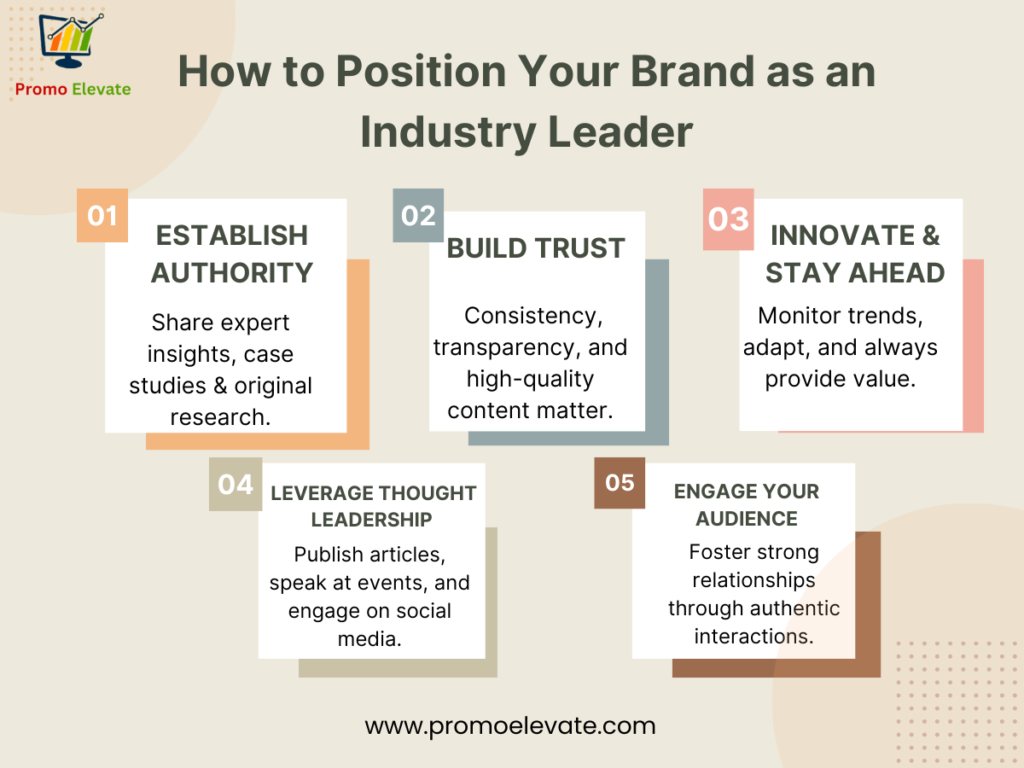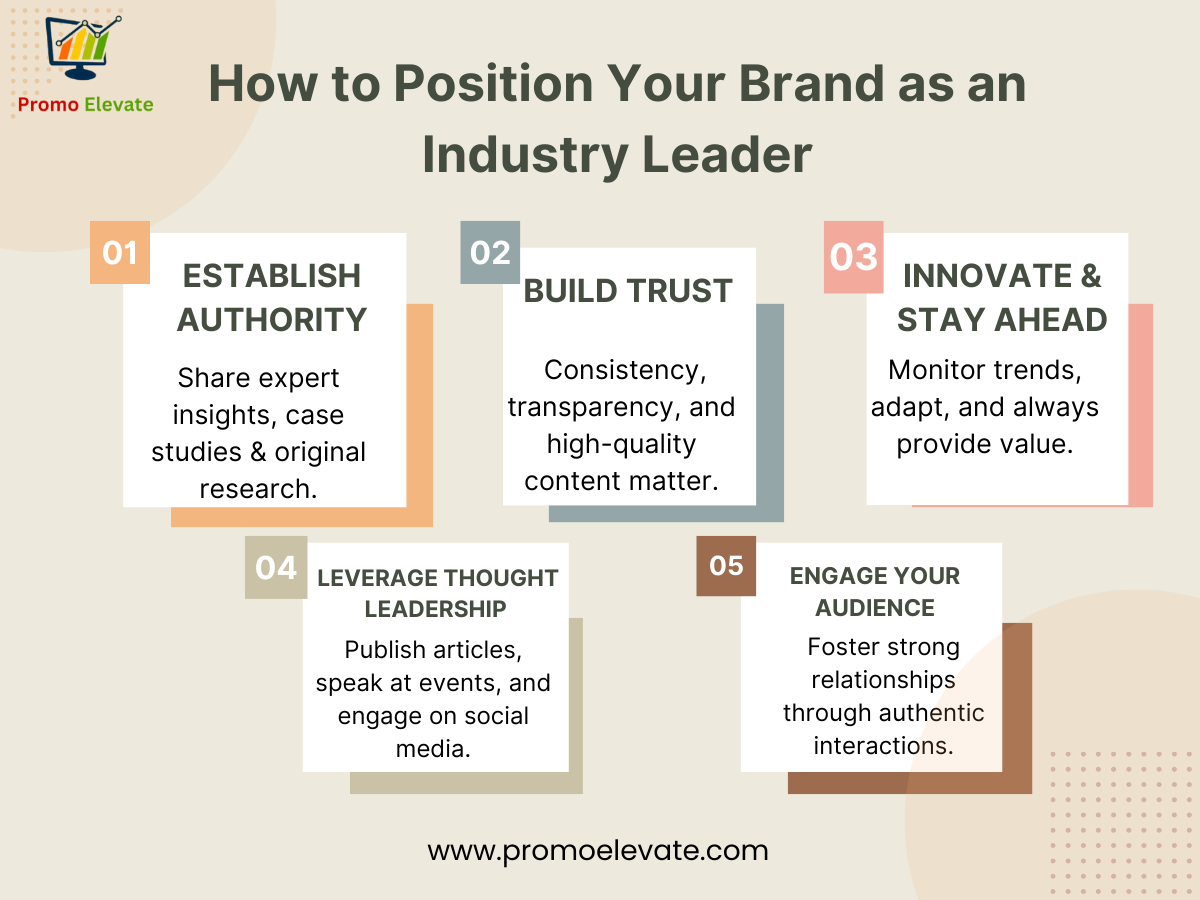
How to Position Your Brand as an Industry Leader

Building a successful brand is more than just offering fantastic products or services—it’s about earning your place as a trusted authority in your field. But what does it indeed mean to be an industry leader? And more importantly, how can your brand achieve this sought-after status?
This guide breaks down practical steps to position your brand as an industry leader. Whether you’re a brand manager building your company’s reputation or an entrepreneur looking to dominate your niche, these strategies will help you establish credibility, increase trust, and gain a competitive edge.
Why Being an Industry Leader Matters
An industry leader is a brand that people look to for innovation, authority, and guidance. These respected brands enjoy increased credibility and trust, substantially influencing markets, stronger customer loyalty, and higher profitability.
Here’s why setting your brand apart as an industry leader matters:
- Credibility and Trust: People naturally gravitate toward brands that demonstrate expertise.
- Market Share Growth: Industry leadership attracts customers and opportunities, increasing visibility and revenue.
- Competitive Differentiation: It solidifies your brand’s unique value in a crowded market.
Think of companies like Nike or Apple. They have mastered branding and brand positioning, ensuring their influence extends beyond their products. How can your business achieve similar success? Start by understanding your market and audience.
Understanding Your Industry and Audience
To begin your leadership journey, you must first develop a thorough understanding of the brand positioning framework within your industry. Here’s how to start:
1. Research Industry Trends
Stay up-to-date with emerging trends and technologies within your field. Use reports, trade publications, and platforms like LinkedIn to follow thought leaders and identify ongoing discussions.
2. Analyze Competitors
Study companies that have the best brand awareness in your industry. What are they doing well? Where are their gaps? This analysis will highlight opportunities for your brand to stand out.
3. Know Your Audience
Your target audience’s understanding is key. Analyze their problems, goals, and needs:
- What challenges do they face?
- Where can you add value?
Align these insights with your unique selling proposition (USP) to create offerings that directly solve their problems.
Understanding your place in the market paves the way for building a strong foundation for your brand.
Building a Strong Brand Foundation
Before you can lead, you need a solid foundation based on clarity, consistency, and authenticity.
1. Define Your Brand Mission, Vision, and Core Values
A powerful brand starts with a clear mission and vision. What does your brand stand for, and what do you aspire to achieve? Define these elements and ensure they resonate throughout the organization.
2. Develop a Distinctive Visual Identity
A strong visual identity makes your brand instantly recognizable, from your logo to colors and typography. Brands like Canva have excelled by ensuring consistency across all touchpoints.
3. Define a Brand Voice
Your communication must feel authentic, whether your tone is casual, professional, or quirky. Writers, marketers, and social media strategists in marketing communication positions can use this voice to resonate with your audience.
4. Storytelling Matters
Share the story of your origin, challenges, and achievements. Customers connect with stories—they humanize your brand and make it relatable.
When your foundation is in place, you can focus on ways to deliver unparalleled value to your audience.
Delivering Exceptional Value and Innovation
Leaders don’t just keep up—they set new standards. To position your brand as an innovator:
- Prioritize Quality: Deliver products or services that consistently exceed expectations.
- Foster Innovation: Stay ahead by introducing fresh ideas. For instance, brands in marketing analyst positions can innovate with data-driven strategies.
- Leverage Customer Feedback: Use reviews and feedback to refine your offerings—always lead with solutions.
Brands like Tesla thrive because they continuously push boundaries while keeping customer needs at the forefront. How can you follow suit? By showcasing thought leadership.
Establishing Thought Leadership
Being seen as a thought leader solidifies your position as an industry expert. Here’s how to use thought leadership strategy effectively:
1. Publish High-Quality Content
Write blogs, white papers, and thought leadership articles that provide valuable insights. Base your content on fundamental customer pain points.
2. Speak and Collaborate
Leverage opportunities like webinars, podcasts, or live panels to showcase expertise. Visibility builds authority within your industry.
3. Create Educational Resources
Offer free resources to your community, such as guides or online courses. Just like HubSpot’s free marketing tools, these resources build trust.
Consistent efforts in thought leadership allow you to engage audiences and provide long-term value.
Leveraging Social Proof and Testimonials
Nothing establishes authority faster than seeing others validate your expertise.
1. Share Case Studies
Highlight how your brand has helped clients achieve results, showcasing quantifiable metrics.
2. Collect and Display Testimonials
Endorsements from influencers, clients, or industry experts build your credibility. Promote these across your website, emails, and social channels.
3. Encourage User-Generated Content
Ask customers for feedback about their experiences. Photos or reviews posted organically create trust and foster community connection.
Networking and Building Relationships
Relationships and connections are the foundation of business growth—and industry leadership.
1. Attend Events
Attend networking events, conferences, or trade shows with your industry. These forums give your brand visibility.
2. Build Partnerships
Collaborations with influencers, stakeholders, and complementary brands allow you to extend your reach and engage new audiences.
3. Be Approachable
Position yourself as a brand that listens, responds, and genuinely cares about building stakeholder trust. Leaders lead by connection.
The Power of Consistent Messaging and PR
Consistency is the backbone of any leadership strategy.
- Strategic PR and Media Features:
Pitch your brand’s stories to prominent media outlets. Work with PR professionals or agencies, tapping into the power of brand strategy consulting.
- Aligned Messages Across All Platforms:
Whether you’re addressing entry-level employees through newsletters or engaging audiences in social media marketing positions, ensure your messaging reflects your position as a trusted brand.
Showcase Impact and Adaptability for Continued Success
Highlight Achievements
Share metrics and awards that demonstrate measurable success. Whether you’ve transformed supply chains or led sustainability efforts, show the broader impact on the industry.
Stay Agile
The business world evolves. Leaders remain adaptable. For example:
- Evaluate industry changes regularly.
- Innovate with product releases or new technology.
- Inspire with resilience during setbacks.
This adaptability ensures relevance and resilience in a rapidly changing landscape.
Becoming an Industry Leader—One Step at a Time
Positioning your brand as an industry leader isn’t an overnight process. It’s a consistent, long-term commitment to understanding your audience, delivering value, and remaining authentic.
Take the first step toward industry leadership today. Whether refining your branding and brand positioning or building a new strategy from scratch, success begins with insight, action, and the right tools.
FAQs
Port Authority is a clothing brand known for its high-quality, professional apparel, including suit jackets. These jackets are often designed for corporate or business settings, offering a polished and professional look. They are popular for their durability, comfort, and style and are usually used for uniforms or branded corporate wear.
Proof of authority helps establish credibility and trust in your brand. It demonstrates expertise, reliability, and leadership in your industry. This can be achieved through certifications, awards, testimonials, case studies, or thought leadership content like blogs, whitepapers, and speaking engagements. By showcasing authority, customers are likely to trust and choose your brand over competitors.
A market-dominating position refers to a brand’s ability to stand out as the go-to choice in its industry. This is achieved by offering unique value, superior quality, or unmatched customer experience that competitors cannot replicate. It often involves a combination of innovation, branding, and strategic marketing to capture and retain a significant market share.
To build trust as leaders in a book:
- Share authentic stories and experiences that resonate with readers.
- Provide actionable insights and practical advice.
- Provide evidence to support your claims through research, data, or case studies.
- Be transparent about challenges and how they were overcome.
- Use a relatable and conversational tone to connect with your audience.
Positioning your brand as an industry leader involves:
- Establishing thought leadership through blogs, webinars, and speaking engagements.
- Building a strong online presence with consistent branding and valuable content.
- Networking with other industry leaders and participating in key events.
- Delivering exceptional value and customer service.
- Showcasing expertise through case studies, testimonials, and awards.
Examples include:
- HubSpot: Positioned as a leader in inbound marketing through educational content and free tools.
- Apple: Apple is known for innovation and premium products, and it sets trends in technology.
- TED Talks: Established as a thought leader by sharing ideas from experts across industries.
To position your brand in the market:
- Identify your unique selling proposition (USP).
- Understand your target audience and their needs.
- Analyze competitors to find gaps in the market.
- Develop a clear and consistent brand message.
- Use marketing channels that resonate with your audience.
To create a brand profile:
- Make sure your brand is clear about its mission and vision, as well as its values.
- Describe your unique selling proposition and key offerings.
- Include your target audience and market positioning.
- Use a consistent tone, style, and visual identity.
- Add testimonials, case studies, or achievements to build credibility.
To market your company on LinkedIn:
- Optimize your company page with a professional logo, banner, and description.
- Share valuable content like articles, updates, and industry insights.
- Engage with your audience through comments and messages.
- Use LinkedIn Ads to target specific demographics.
- Encourage employees to share and engage with company posts.


